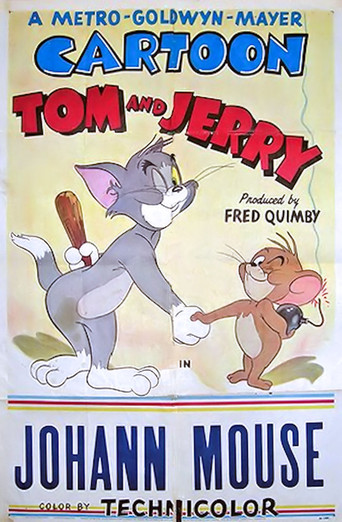
Note: Spoilers ahead.
This short film marked the seventh and last Tom and Jerry cartoon to win the Academy Award to win the Academy Award for Best Animated Short Film (and the 75th Tom and Jerry short overall). It's competition this year was Little Johnny Jet (1953, MGM), Madeline (1952, UPA), Pink and Blue Blues (1952, UPA, starring Mr. Magoo) and The Romance of Transportation in Canada (1952, National Film Board of Canada). Though not the first (this was also true of 1950), this is one of the earliest years in which a Disney film was not nominated. This shows how at this time critical and public tastes where switching from the lush animation of Disney to the more stylized modern art approach from the UPA studio. This change in taste also helps us understand why no more Tom and Jerry shorts would win after this.
In this short film, Tom and Jerry live in the home of the infamous composer Johann Strauss. Jerry finds himself unable to stop himself from dancing whenever Strauss plays. Every time this happens Tom takes this chance to try and catch Jerry. However, when Strauss leaves on a trip, Tom wonders how he will get Jerry to come out of his hole. Tom then learns to play piano. Just when he is just about to catch Jerry the two are discovered by the servants, who are amazed to see a cat play the piano and a mouse dance. Before long the two are performing before the emperor himself.
This is a very charming cartoon. The film has a wonderful storybook feel to it. This comes from both the narration (provided by character actor Hans Conried (animation fans might know him for voiced both Captain Hook and George Darling in Disney's Peter Pan (1953))) and the wonderful art style. The use of actual storybook pages with storybook style illustrations of the characters are especially wonderful. This helps this film stand out as something that feels unique among the other entries in this series. That is something that is rare in a cartoon series that has been around over a decade, but it is very true here. This cartoon also benefits from some wonderful character animation, especially when Jerry is dancing, and a wonderful use of Strauss' classical pieces. The only real problem here is that there is not as many laughs here as you might expect. This film only really has one good gag (Tom's piano lesson). However, I will admit it is a great one.
The credited animators on this film are Kenneth Muse, Ray Patterson, Ed Barge and Irven Spence. The credited background artist is Robert Gentle. Hans Conried receives a voice credit making him the first voice artist to receive credit on a Tom and Jerry cartoon. Though Scott Bradley receives the music credit. Jakob Gimpel is given a credit stating, "Piano Arrangements Created and Played by." Jakob Kimbell was a respected concert pianist and music professor. He would also work as a film composer on such movies as Gaslight (1944), Possessed (1947), Letter from an Unkown Woman (1948) and Planet of the Apes (1968). He also played piano on the Bugs Bunny cartoon, Rhapsody Rabbit (1946). A scene from Johann Mouse would later be reused in the cheater Tom and Jerry short, Shutter Bugged Cat (1967).
Below is the movie poster for this film. It is the same one that was used for the last couple cartoons, only with the title changed.

Resources Used
Of Mice and Magic: A History of American Animated Cartoons by Leonard Maltin
https://tomandjerry.fandom.com/wiki/Johann_Mouse




No comments:
Post a Comment